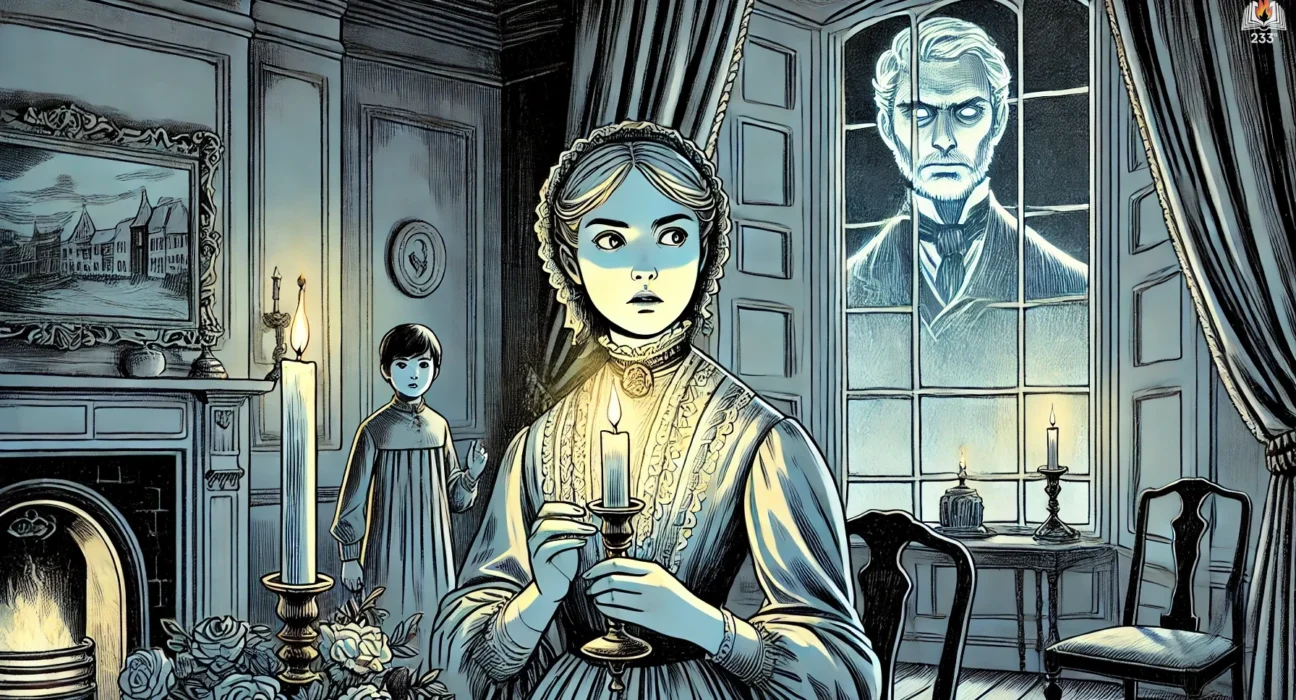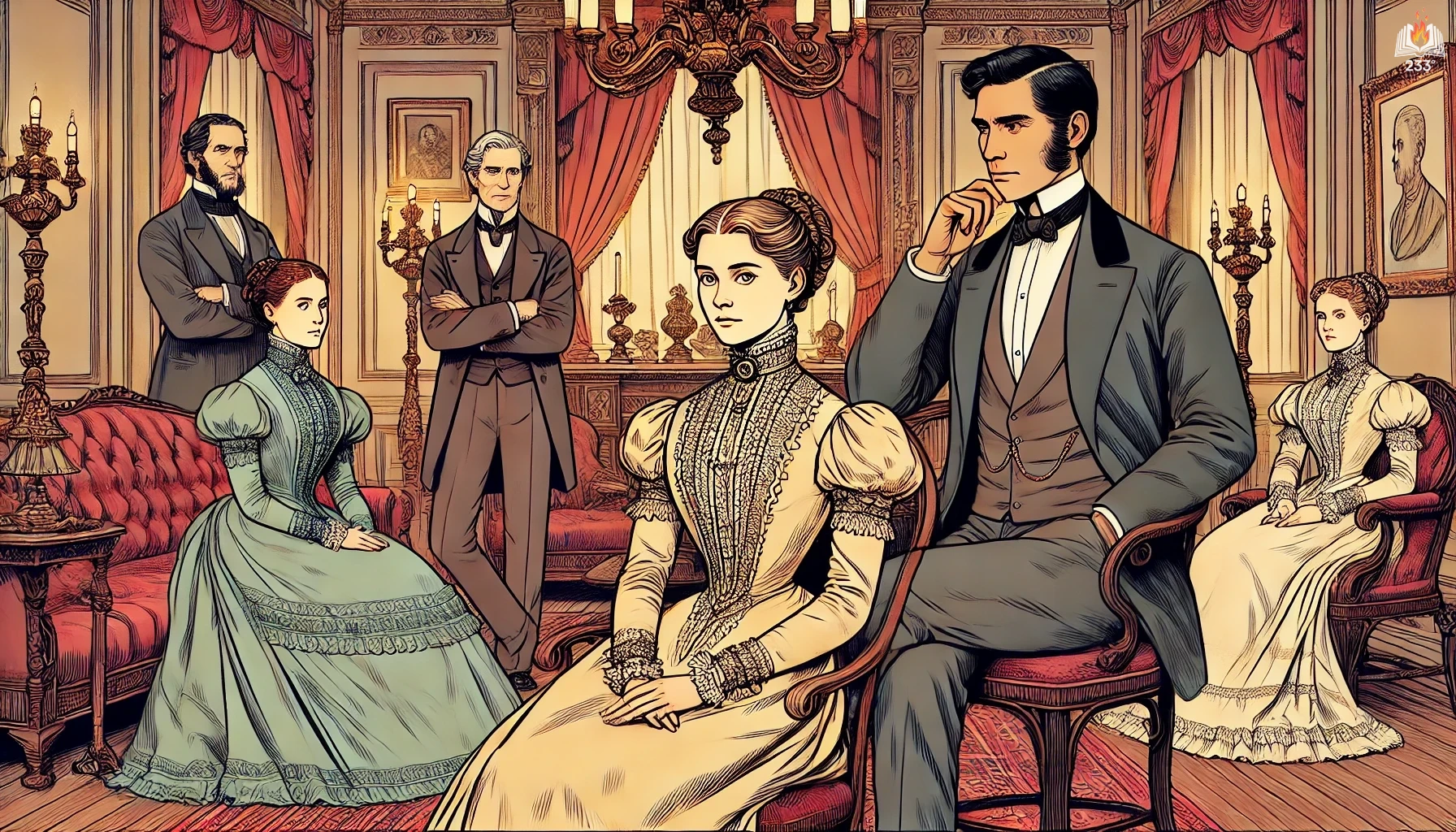“The Turn of the Screw,” written by Henry James and published in 1898, is a classic novella in the horror genre. It tells the story of a young governess who is hired to look after two children at a remote estate. As she takes up her new position, she becomes increasingly convinced that the estate is haunted by malevolent spirits intent on corrupting the children.
Plot Summary
In the heart of England, at a grand estate called Bly, a young, inexperienced governess arrives to take up her new position. Hired by a wealthy bachelor uncle, she is charged with the care of two orphaned children, Miles and Flora, under the strict condition that she must never contact their guardian. The housekeeper, Mrs. Grose, a warm and supportive woman, welcomes her. The governess is immediately enchanted by her young charges. Flora, a delicate and beautiful child, is already at Bly, while Miles is expected shortly, having been sent home from his boarding school under mysterious circumstances.
The estate, with its sprawling grounds and ancient architecture, has an air of both charm and ominous seclusion. Though the governess is unsettled by the news of Miles’s unexplained expulsion, his arrival dispels her worries. He is angelically beautiful and behaves with such grace and charm that she quickly dismisses any suspicion about his character. Yet, an undercurrent of unease settles within her.
One evening, while walking in the estate’s gardens, the governess sees a man staring at her from atop a distant tower. He is unfamiliar, and his appearance sends a chill through her. Later, she glimpses him again through a window, his gaze fixed intently upon her. When she describes the man to Mrs. Grose, the housekeeper is horrified. The governess has perfectly described Peter Quint, the late valet who had a corrupting influence over the estate’s former governess, Miss Jessel, and possibly the children. Both Quint and Miss Jessel are dead, yet the governess is convinced they have returned, seeking to possess Miles and Flora.
As days pass, the governess becomes increasingly vigilant, watching the children closely for signs of the supernatural influence. To her, they appear remarkably innocent, yet she grows certain that they are hiding knowledge of Quint and Miss Jessel’s presence. The children continue to act normally, playing games and engaging in their studies, but their behavior sometimes strikes the governess as unnaturally perfect, as if they are complicit in a sinister game.
The governess begins to see the ghosts more frequently, yet they never appear when others are present. She believes Quint and Miss Jessel communicate with the children in secret, tempting them into a world of darkness. The children, however, deny seeing anything unusual. Flora, especially, feigns ignorance with a childlike innocence that the governess finds increasingly disturbing. Flora’s sweetness becomes suspect in her eyes, a mask concealing the truth of her encounters with Miss Jessel’s ghost. The governess’s isolation deepens as Mrs. Grose, though supportive, remains skeptical of the supernatural events.
One night, the governess discovers Miles outside in the moonlight, claiming he wanted to show her he could be “bad.” She is torn between her affection for him and her fear that he is already lost to Quint’s influence. Her resolve hardens; she vows to protect the children at any cost, even if it means confronting the ghosts herself. She begins to question her sanity, wondering if the apparitions are real or merely figments of her imagination, yet the conviction of the danger grows stronger.
The tension mounts when the governess sees Miss Jessel’s ghost near the lake where Flora often plays. She confronts Flora, pointing out the ghostly figure, but the child denies seeing anything. Flora’s demeanor changes; she becomes hostile and falls ill, her innocence shattered in the eyes of the governess. Mrs. Grose takes Flora away, at the governess’s insistence, to distance her from the corrupting influence of the estate. Miles remains, and the governess believes this is the final showdown between herself and the sinister forces at play.
Alone with Miles, the governess presses him for the truth about what he knows of Quint and Miss Jessel. Miles initially deflects her questions with his usual charm, but as she continues to probe, he becomes agitated. In a climactic moment, the governess sees Quint’s ghost staring at them through the window. Desperate, she shields Miles from the apparition, declaring her victory in protecting him. But as she embraces him, she realizes his body is lifeless in her arms.
The governess is left alone, holding the lifeless boy, her triumph hollow and her sanity hanging by a thread. The spirits of Peter Quint and Miss Jessel have vanished, leaving only the question of whether they were ever truly there or merely the product of a mind unhinged by fear and obsession. In the end, the line between reality and imagination blurs, leaving the governess—and the reader—trapped in a world where innocence and evil are impossibly intertwined.
Main Characters
- The Governess: The protagonist and narrator of the story. A young, inexperienced woman hired to take care of two orphaned children. She is determined, imaginative, and increasingly paranoid as she becomes convinced that the estate is haunted.
- Miles: A charming and intelligent young boy who is expelled from school for unspecified reasons. He seems innocent but is at the center of the governess’s concerns about the supernatural influence.
- Flora: Miles’s younger sister, a sweet and beautiful child who initially appears innocent but becomes implicated in the governess’s fears of supernatural corruption.
- Mrs. Grose: The housekeeper at Bly, the estate where the story is set. She is kind-hearted and supportive of the governess, though skeptical about the existence of the ghosts.
- Peter Quint: The former valet who is now deceased. The governess believes he haunts Bly and is attempting to corrupt the children.
- Miss Jessel: The previous governess who had an inappropriate relationship with Peter Quint. The current governess believes that Miss Jessel’s spirit is also haunting Bly.
Theme
- The Unreliable Narrator: The governess narrates the story, but her reliability is in question. Her increasing paranoia and potential hallucinations make readers question the reality of the supernatural events.
- Innocence and Corruption: The story revolves around the governess’s belief that the ghosts of Peter Quint and Miss Jessel are trying to corrupt the children, who embody innocence. The ambiguity of whether the children are truly innocent or complicit in some way adds to the story’s tension.
- Isolation and Fear: The remote setting of Bly, combined with the governess’s growing sense of isolation, amplifies the fear and suspense. The estate becomes a claustrophobic space where the boundary between the supernatural and psychological blurs.
- Social Class and Power Dynamics: The novella explores the power dynamics between the governess, the children, and the other servants. It hints at issues of class and social status, particularly in the relationships between the characters.
Writing Style and Tone
Henry James’s writing style in “The Turn of the Screw” is characterized by intricate sentences and a narrative structure that builds suspense through ambiguity. His prose is dense, with a focus on the inner thoughts and emotions of the governess, making the reader question her perceptions.
The tone is one of growing dread and uncertainty, crafted through meticulous detail and the slow revelation of information. James uses a limited point of view, allowing readers to see the events only through the governess’s perspective, which enhances the psychological horror and the sense of unreliable narration. The language is formal and elaborate, fitting the period in which it was written, and contributes to the gothic atmosphere of the story.
We hope this summary has sparked your interest and would appreciate you following Celsius 233 on social media:
There’s a treasure trove of other fascinating book summaries waiting for you. Check out our collection of stories that inspire, thrill, and provoke thought, just like this one by checking out the Book Shelf or the Library
Remember, while our summaries capture the essence, they can never replace the full experience of reading the book. If this summary intrigued you, consider diving into the complete story – buy the book and immerse yourself in the author’s original work.
If you want to request a book summary, click here.
When Saurabh is not working/watching football/reading books/traveling, you can reach him via Twitter/X, LinkedIn, or Threads
Restart reading!








